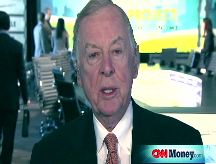Oil jumps more than $2
Crude prices jump 6.4% as gasoline stockpiles fall more than expected, but crude supply remains above average for this time of year.
NEW YORK (CNNMoney.com) -- Oil gained more than $2 a barrel Wednesday, after a government report showed that while supplies of gasoline fell much more than expected, crude stockpiles continue to grow amid sluggish demand.
Light sweet crude settled $2.54 higher to $42.50 a barrel after reaching an intraday high of $42.78 earlier in the session.
Oil traded up 59 cents to $40.55 just prior to the release of the Energy Information Administration's weekly inventory report.
Stockpiles of gasoline fell by 3.4 million barrels in the week ended Feb. 20, the EIA said.
That's in the lower half of the average range for this time of year. Analysts expected a decrease of 300,000 barrels, according to a consensus estimate of industry analysts surveyed by Platts, a global energy information provider.
"The market was really impressed with the shocking gasoline number, which caused an initial bullish jump," said Phil Flynn, senior analyst at Alaron Trading.
The price of gasoline has declined for the 10th consecutive day, inspiring consumers to fill their tanks, Flynn said.
The national average price for a gallon of regular unleaded fell to $1.891 from $1.90, according to motorist group AAA.
The EIA report said crude stocks increased by 700,000 barrels, while analysts predicted an increase of 2.25 million barrels.
Crude stocks are still above the upper limit of the average range for this time of year, the EIA report said. Flynn said supply is up 17.2% from the previous year.
The EIA report also said distillates, which are used to make heating oil and diesel fuel, increased by 800,000 barrels, with the stockpile above the upper limit of the average range. Analysts were looking for a decrease of 1.8 million barrels.
The economic slowdown has reduced demand for oil as crude stockpiles continue to grow.
The Organization of the Petroleum Exporting Countries - whose members produce about 40% of the world's crude - has been pressured to boost oil prices, which peaked at a record high of $147.27 a barrel in July.
OPEC agreed on cuts totaling 4.2 million barrels per day since last September. Flynn said he thought OPEC cuts were already priced into the market.
Though production cuts cheered investors, OPEC's actions are ultimately a disservice to attempts to boost oil demand, Flynn said.
"Raising oil prices in a recession makes the recession worse," Flynn said. "They don't understand they're hurting their own cause by cutting when they should let the market play out."
The energy boom earlier in the decade stemmed from oil prices falling low enough to stimulate demand, Flynn said.
OPEC may need to settle for a lower price for a while, Flynn said, as he believes crude needs to fall more before it will see sustained gains.
"We'd already be at the $20-something mark if OPEC wasn't cutting," he said. "But that mark is inevitable, and crude needs to scrape the floor if we hope to see it bounce back up." ![]()



